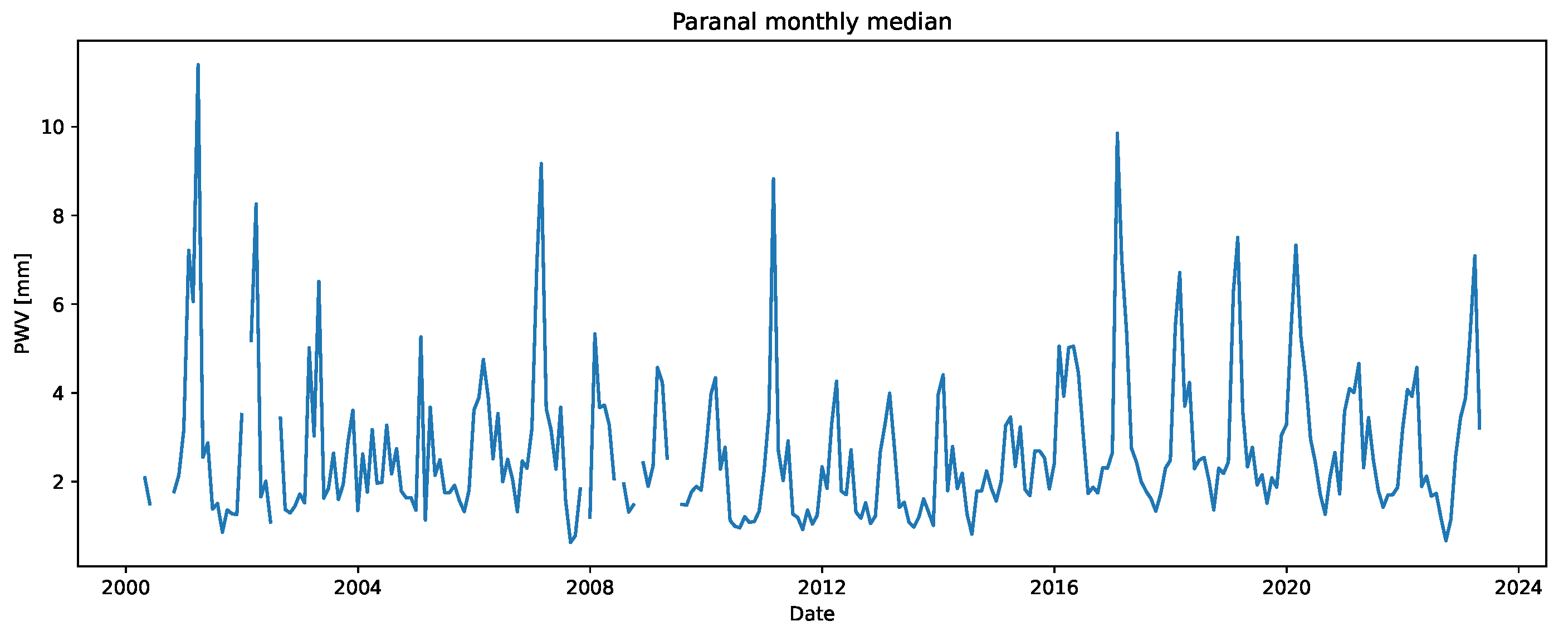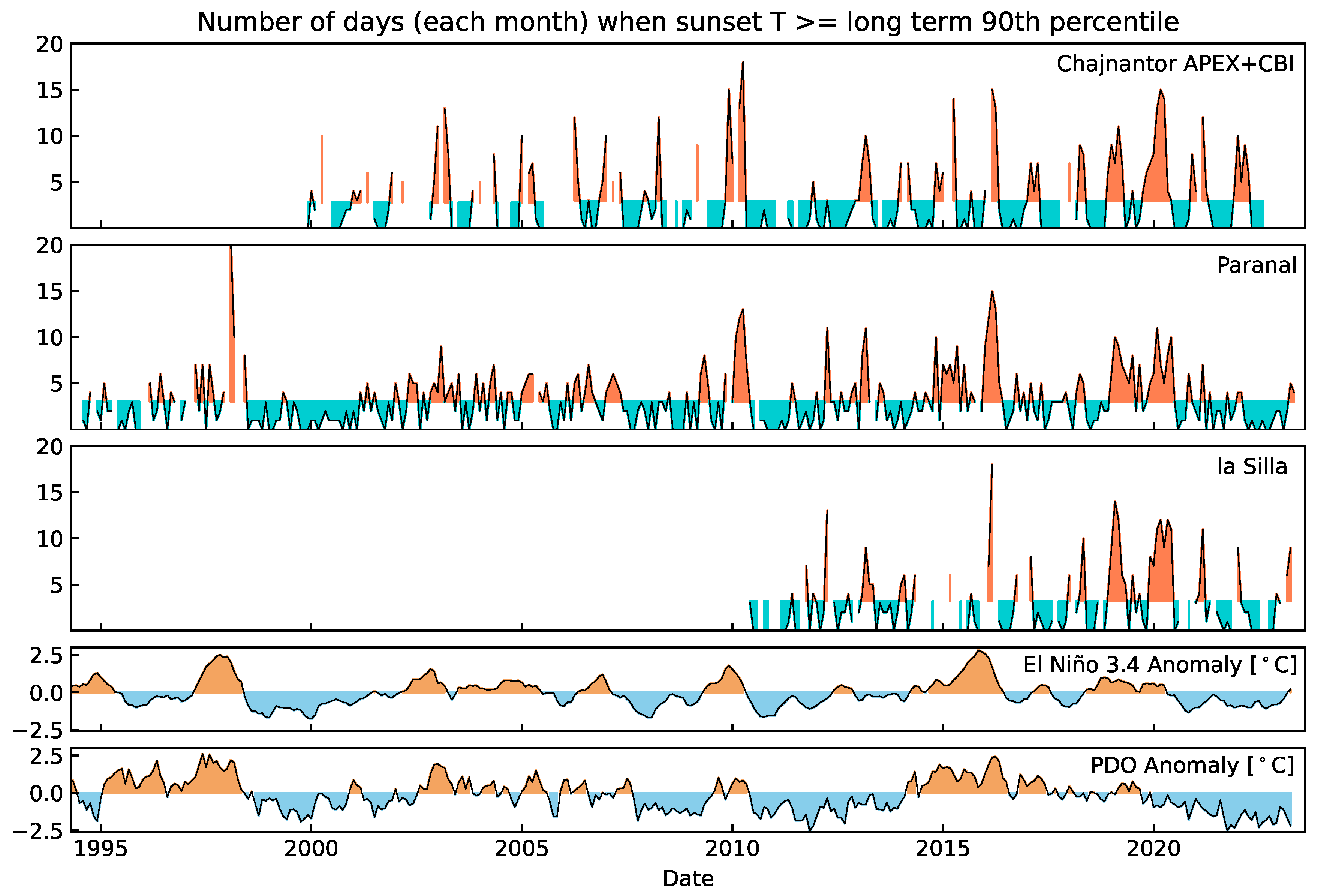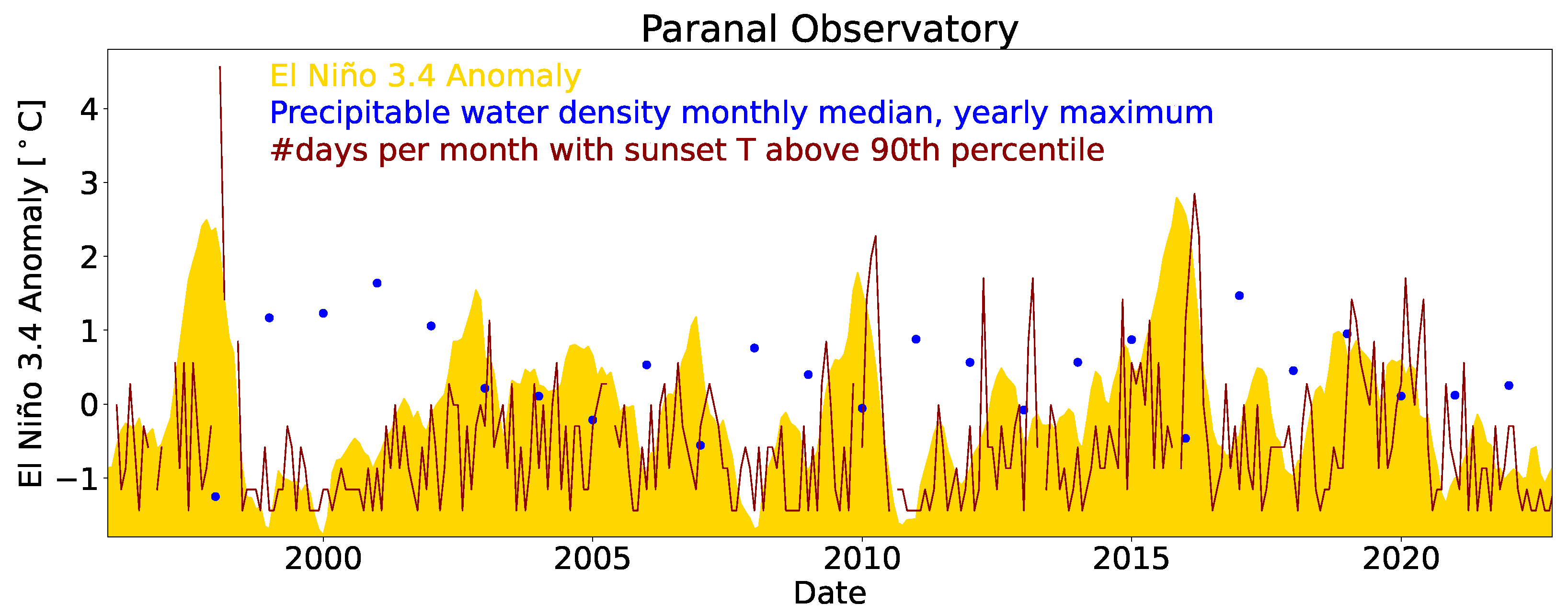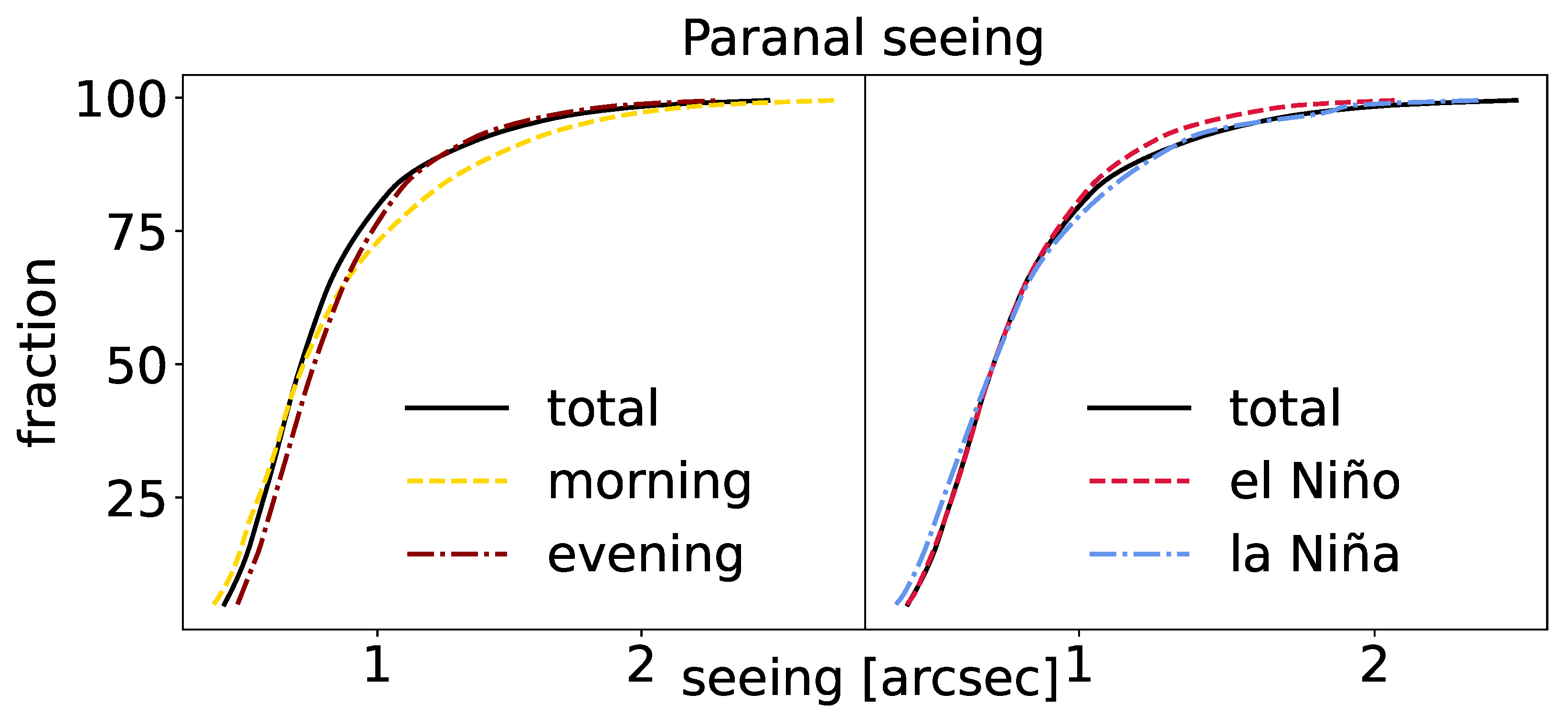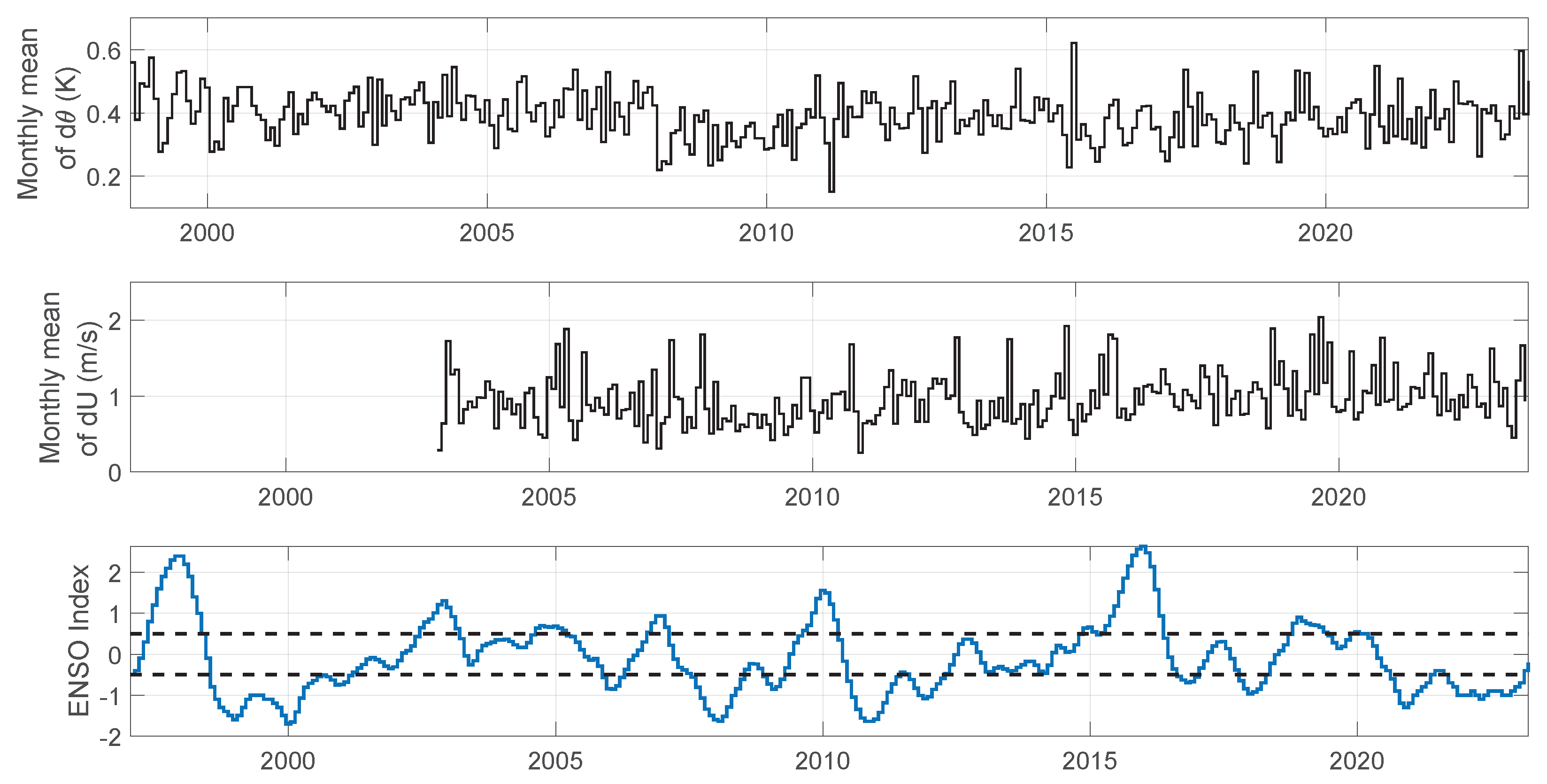3.1. European Southern Observatory Sites Temperature Trends
All sites in our study are found at geographical elevations 2400 m above sea level (MASL). However, both the la Silla and the Paranal Observatory are close to the coastal line and at the lower boundary of high-elevation sites. On the other hand, the Chajnantor site lies at over 5000 MASL on the western slope of the Andes mountains. This allows us to provide some insights into how temperature trends change with altitude. The significance of temperature trends, as a function of site (altitude), was assessed using the Mann–Kendall (MK) test. See
Appendix A for the tables for all sites together with a more in-depth analysis of the temporal warming variations for the Paranal Observatory (
Appendix A-
Table A2 and
Table A3).
Our results show a significant increase in temperatures at the Chajnantor site, with rising trends for temperatures during the austral summer. These trends confirm the projected altitude-dependent warming acceleration, both globally [
26] and for future observatories [
27]. In the austral autumn, the minimum temperatures at the Chajnantor site exhibit an increase of
decade, twice as fast as any other parameter. A consistent rise in the minimum temperature during the austral autumn (and the maximum temperature in summer) extends across all sites. Previous studies on climate trends in Chile have demonstrated substantial warming during the austral autumn and summer while suggesting cooling during spring and winter [
28] linked to climate change [
29]. Our findings corroborate a strong warming trend, specifically evident in the minimum temperature during autumn, which implies reduced cool periods leading up to winter. This indicates a lengthening of the ablation season in the high Andes with an impact on the glacier mass balance [
28]. Nonetheless, the climate forcing responsible for glacial shrinkage in Chile is a complex subject [
30] and beyond the scope of this work.
While a definitive warming trend attributed to global warming is evident across European Southern Observatory sites, annual-level variations cannot be solely ascribed to climate change. We investigated the link between extreme warm events when the daily maximum ambient temperature exceeded the 90th percentile of the long-term temperature record and ENSO (
Figure 2). Our findings reveal a distinct correlation between the occurrence of warm surface temperature anomalies and the Niño3.4 index across sites. Further details on the correlations for all sites can be found in
Table 3 and in
Appendix A.
3.2. European Southern Observatory Sites Surface Water Vapour Density Trends and Precipitable Water Vapour
The surface water vapour density (WVD) in the Paranal and the la Silla Observatories is anti-correlated with ENSO (see
Table 4). Years during strong EN phases show no surface-level wet periods, while there are a larger number of days with temperatures above the long-term 90th quantile, e.g., in 1998, in 2010, and in 2016 (see
Figure 3). While a decrease in WVD is also observed for the Chajnantor site during strong EN phases, the overall WVD is extremely low, and no correlation could be determined in our short data series. The most important site to quantify is the Paranal Observatory due to its close proximity to the construction site (Cerro Armazones) of the future Extremely Large Telescope (ELT) [
31].
The monthly median values of precipitable water vapour (PWV) for the Paranal Observatory are shown in
Figure 1 and no augmentation in minimum PWV with time is discernible; however, a marginal decadal oscillation can be inferred. If anything, what is clearly visible is the variability in the maximum PWV events during the austral summers. This variability is most likely influenced by the predominant position of the Bolivian high-pressure centre during summer months [
32,
33,
34], which leads to dry anomalies during the normally wet summer for the combination of EN/PDO(+) [
9]. The PWV long-term record for the Chajnantor site was analysed in [
13], and no evidence of PWV trends over the 20 years of data was found, in agreement with our results for the Paranal Observatory.
3.3. The Impact on Astronomical Seeing
In observational astronomy, and as a more technical addition to the definition in
Section 1, seeing is a term that refers to the broadening in the point-spread-function (PSF) of a point-like source (a star) attributed to atmospheric optical turbulence. The broadening occurs due to the scattering of light away from the core of the PSF because of rapid fluctuations in the air index of refraction along the path the starlight follows through the atmosphere to an imaging detector.
In optical wavelengths, the index of refraction fluctuation is dominated by the turbulent mixing of air of different temperatures [
35]. The effects of turbulent fluctuations of humidity in the air index of refraction are more relevant for light in the infrared and radio wavelengths [
36]. In this paper, we refer to seeing, in the optical band, more specifically as measured by the differential image motion monitor (DIMM) instrument at a wavelength of 500 nm. In simple terms, seeing is a measure of the angular size, in arcsecs, of the PSF at the half-intensity point and at the first order driven by changes in wind direction and temperature gradients. While it is understood in detail how seeing is influenced by environmental parameters, predictive tools for seeing on longer time scales are not available to the community.
In the context of the ELT, the impact of climate variations on atmospheric turbulence and, thus, seeing at the Paranal Observatory is of the utmost importance. As stated above, the temperature gradient has an important impact on seeing. This gradient is naturally largest at sunset when the surface and telescope domes are heated from the strong solar irradiation in the Atacama desert. The authors of [
37] studied the amount of time each year that the sunset temperature was above 16
C for the period 2008–2020. The value of 16
C is the maximum temperature at which the telescope dome environments can be maintained while still providing safe cooling to the electronics equipment. We have expanded the analysis to include the full available time series 1994 to 2022 and confirm their trends (see
Figure 4). The yearly fraction of sunset surface air temperatures exceeding 16
C has increased at a rate of over
per decade, reaching up to a 20–25% yearly fraction during the last EN phase in 2018–2019. This trend is in line with global warming, as confirmed via the MK statistical test. Because of the necessary cooling within the telescope dome environments, on warmer days (temperatures at sunset above 16
C), the domes are cooler than the external ambient temperature at the time of dome opening. In [
37], it is inferred that this particular temperature gradient leads to stronger turbulence. However, we may argue that the internal and cooler atmosphere inside the dome is stratified and convection is, thus, inhibited. That said, this may require a specific study on the science image quality as a function of the difference in temperature between the internal dome environment and the external air. At least, in terms of atmospheric seeing, our study of evening and morning twilight seeing compared to total seeing for the most affected years (2016–2021) shows that the fraction of high-seeing events (>1.6 arcseconds) for the evening twilight is equal to the total seeing statistics (see
Figure 5 and
Table A5).
Furthermore, and motivated by the work of [
37], we analysed the near surface level temperature record to check for possible trends in temperature gradients between the 30 m and 2 m height from the ground level. Similarly, we also analysed the vertical gradient in the horizontal wind speed from wind measurements performed at 30 m and 10 m above ground level. The long-term record for the monthly means of the vertical differences in temperature and horizontal wind speed are shown in
Figure 6. Our results show seasonal variability, but, overall, the temperature and horizontal wind speed gradient have remained stable, within their natural variability. For completeness, the gradients are shown together with the ENSO index. This result on the wind speed and temperature gradient expands the exhaustive work on the relation of seeing and wind speed and temperature gradients in the context of climate change from 2009 at the Paranal Observatory [
7]. In that work, the authors analysed the data from 1990 to 1998 and from 1998 to 2008 and concluded that climate change had no significant impact on seeing in this time period. Additionally, and most importantly, they concluded that the Armazones site, now host of the ELT construction, was unaffected both by seeing changes due to climate change or due to EN or LN phases. We expand their findings with complementary data from the decade following their study.
To better understand the potential impact of ENSO on seeing, we studied the seeing during the night, separating out especially strong EN/LN phases (see
Appendix B-
Table A6 and
Table A7) and found no significant difference in seeing, although dry EN phases showed less variance in seeing.
Figure 7 shows the seeing at the Paranal Observatory in the period 1998–2023. This time series is affected by biases induced by construction and the proximity of the telescope buildings to the former seeing monitor tower (1998-April 2016) [
37], a position prone to the influence of surface-layer turbulence re-circulation. The new seeing monitor instrument (DIMM) was then moved away from the telescope building and raised up, from 5 m above ground level to 7 m. Due to this improvement, the seeing came back to the best long-term values before construction, showing that no gradual increase with time was taking place. In the latest record, we may see evidence of an increase in the lowest seeing values, but the time series is still too short to attempt a correlation with ENSO or climate change.
Moreover, we explored a possible trend between the surface-level turbulence differences between the EN and LN phases of ENSO via the Richardson number. Our results, derived from the data in
Figure 6 and taking
= 314 K in Equation (
4), show a nearly constant long-term Richardson number of about 0.2–0.3, consistent with the earlier work of [
7], and no differences between the EN and LN periods.
As well as the integrated (whole-atmosphere) seeing in
Figure 7, we have included the free-atmosphere seeing from 2016 onwards, which does not show any particular trend either. Free-atmosphere seeing results from optical turbulence from 250 m onwards, away from the surface layer, up to the top of the troposphere. The MASS instrument allows measuring the free-atmosphere seeing [
11], as well as other parameters important for observational astronomy.
The period after 2020 was associated with LN conditions, and our results, as shown in
Appendix B, indicate a higher seeing variability during LN periods. As we are entering (2023) into the next EN period, the future record of seeing will show if the lowest seeing conditions decrease compared to the 2016–2020 period characterised by mainly neutral ENSO conditions. Nonetheless, it is important to state that the seeing conditions in the Paranal and Cerro Armazones region (ELT site) remain exceptional for seeing-limited astronomical observations and, at large, are unaffected by ENSO and climate change, confirming the results from a decade prior [
7].
